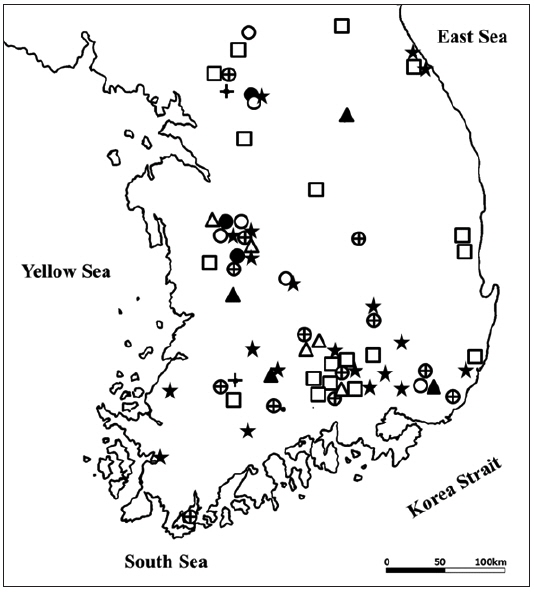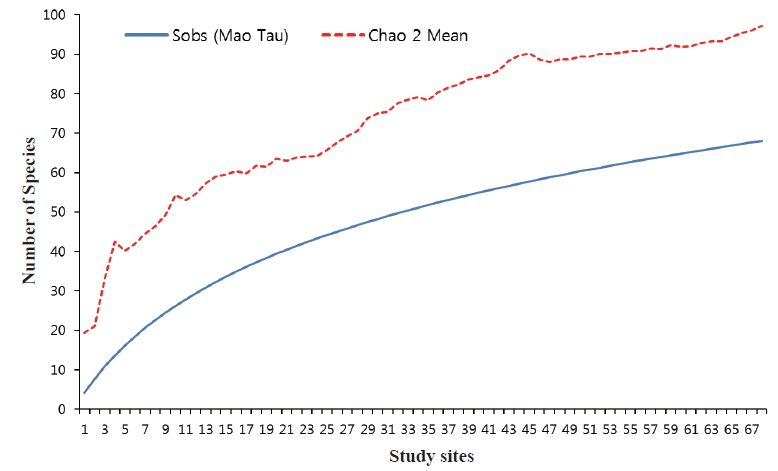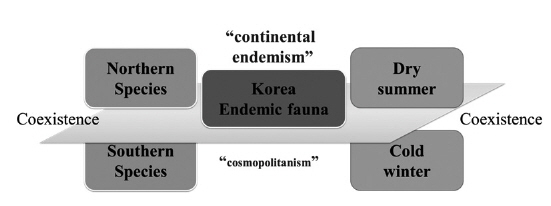



We investigated cladoceran fauna from 71 study areas in South Korea. Sixty-two taxa were found, of which there were 30 planktonic and 25 littoral-benthic cladoceran species. In the present study, taxa of cladocera were identified by biographical traits. Species endemic to the Far East were found in the northernmost areas of South Korea, whereas Palearctic species were found in the southernmost areas. Generally, coexistence of cladoceran species in northern and southern areas was observed, implying possible faunistic complexes of cladocera in various areas of South Korea. We believe that further studies conducted in different habitats will greatly expand our knowledge of the biodiversity of cladocera in South Korea.
Cladocera is one of the major zooplankton groups in various freshwater habitats, where few other species have managed to penetrate. Cladocerans generally prefer lentic water, and are therefore uncommon in lotic water bodies. Most biologists regard cladocerans as planktonic (as represented by the well-known genus
The order Cladocera comprises four sub-orders: Anomopoda Sars, 1865, Ctenopoda Sars, 1865, Haplopoda Sars, 1865 and Onychopoda Sars, 1865 (Fryer 1987). Each of them can be alternatively identified as Anomopoda, Ctenopoda, Haplopoda, and Onychopoda, respectively. These sub-orders further comprise more than 700 species and 100 genera. Over the last two decades, significant progress has been made in the study of some genera of Ctenopoda (Korovchinsky 2004), Anomopoda (Smirnov 1992, 1996, 1998, Kotov and Štifter 2006, Van Damme and Dumont 2008, Kotov 2009, Sinev 2009) and Haplopoda (Korovchinsky 2009), using morphological analysis. Although considerable progress has been made recently in cladoceran taxonomy, there are still many gaps in our knowledge. According to Forró et al. (2008), overall cladoceran species richness is probably up to four times higher than what is currently known.
Much work is required of cladoceran taxonomists in different regions worldwide (Korovchinsky 2013). Progress in the classification of Cladocera needs to be accompanied by studies of the regional fauna of the Iberian Peninsula (Alonso 1996). Besides the studies of Uéno (1937) and Manujlova (1964), cladocera of the northern part of East Asia have not garnered much attention, despite its tremendous diversity. As a result, the biology of freshwater zooplankton is poorly understood, outside of the Nearctic and Western Palearctic (Benzie 2005).
Although in recent years, endemic species or lineages have not been reported in Asia, eastern Russia, and surrounding territories, Glagolev (1995) and Ishikawa (1895a, 1895b, 1896) have described several species endemic to Asia. Similar studies are lacking in the Holarctic, in contrast to impressive advances being made in tropical and subtropical countries (Elmoor-Loureiro 2000, Maiphae et al. 2008). From a zoogeographical point of view, the diversity of cladocera in the Palearctic is greater than that in any other zone (Frey 1987, Forró et al. 2008). Consequently, the Korean Peninsula, which is a part of the Paleractic ecozone, is likely to have a very high diversity of cladocera.
This paper aims to present a brief overview of cladoceran fauna, based on zoogeographical traits, and a quantitative estimation of cladoceran species diversity in the Korean Peninsula.
In 71 sites in South Korea (Fig. 1), samples were taken from different biotopes, including lakes, swamps, ponds, brackish waters, and rice paddies, over the period 2009-2014. In the case of small ponds or puddles, a total sample was obtained by combining smaller samples from different parts of the body of water. In the case of larger bodies of water, several samples were taken from different biotopes. The samples were taken using plankton and dip nets that were placed over macrophytes and near-shore substrates. Because of insufficient data on abiotic factors, environmental data were excluded from this study.
>
Sample collection and Identification
Each sample was filtered through nets with a mesh size of approximately 30–100 μm. All filtered samples were thoroughly washed with 95% alcohol. Determination of cladoceran classification was accomplished swith the aid of a binocular stereoscopic microscope at 10–40× magnification, and they were further observed under a compound optical microscope, Zeiss Axioscop II (Carl Zeiss, Germany).
This study used current species names, from the most recent available literature and published papers in Korea (Jeong et al. 2014, Kotov et al. 2012), in addition to the checklist of FADA (2013).
All data for continental South Korea were compiled (Fig. 1), and EstimateS 9.0 (Longino and Colwell 1997) was used to estimate total species richness of cladocera in the region. Accumulation curves were plotted by computing Chao 2 estimators (EstimateS). In cases of a relatively small sample size, the estimates for the species richness were computed by using 95% confidence intervals.
>
Cladoceran fauna from South Korea
We identified 62 cladoceran species in 71 locations, 55 of which were identified to the species level. In eight cases, we were able to identify the taxon to the generic level only (Table 1). In a few cases, specimens either were juveniles, or were deformed, displaying morphologically intermediary features of the known taxa.
[Table 1.] Cladocerans sampled in study sites throughout South Korea during the period 2009?2014
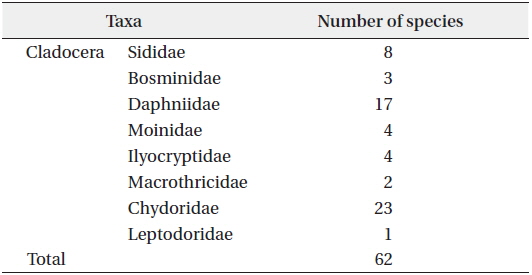
Cladocerans sampled in study sites throughout South Korea during the period 2009?2014
Chydorids were the most diverse group of cladocera, followed by daphniids and sidids (Table 1). Other families were represented by fewer species (Tables 1 and 2). These results were quite expected, as chydorids compose approximately half of all cladocerans worldwide (Forró et al. 2008). The frequency of planktonic species was relatively high (Table 2). Among the cladocerans sampled, 30 ecological groups were identified as planktonic species (both pelagic and sub-littoral), and 25 identified as littoral and benthic species (Table 2).
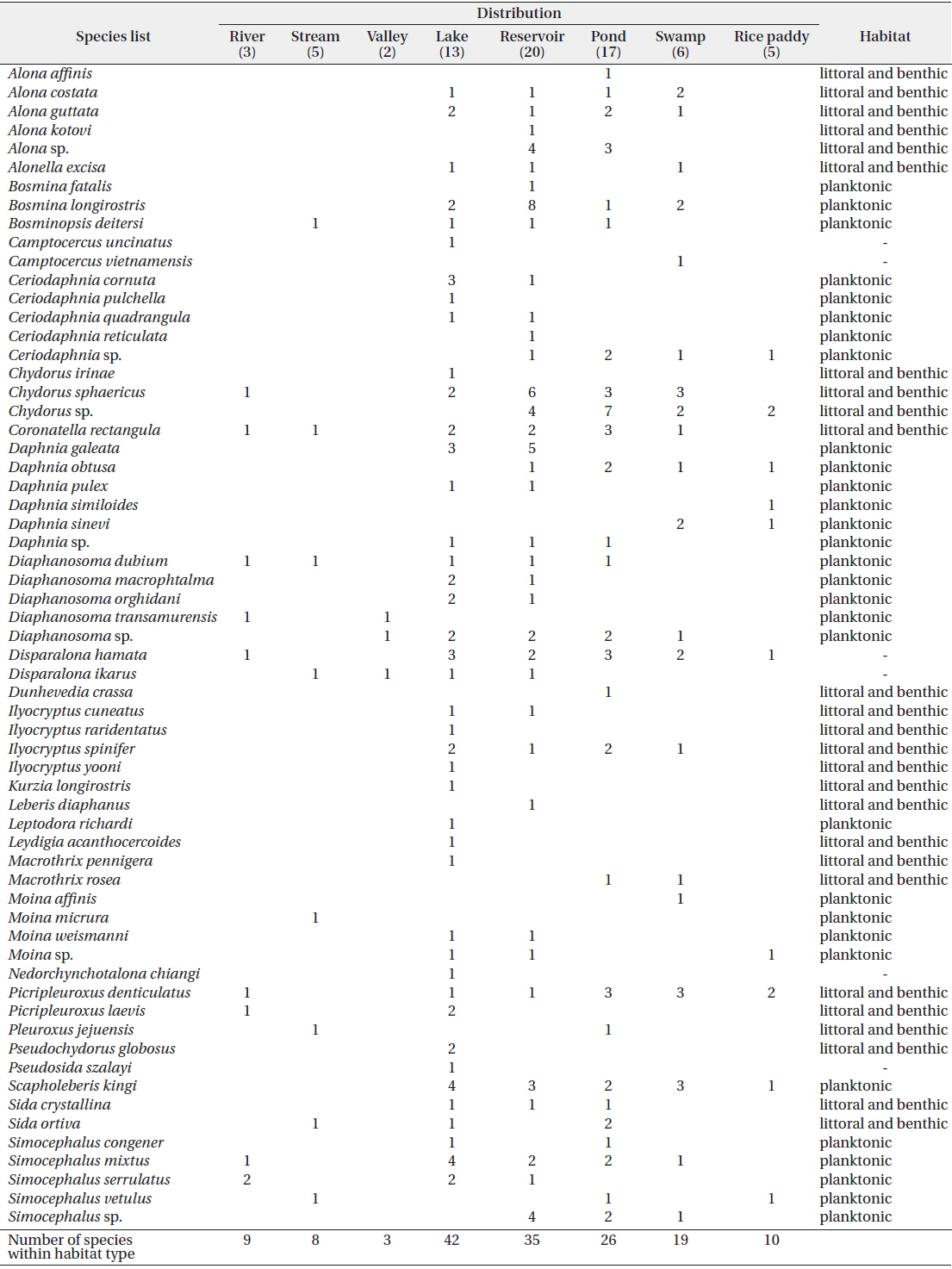
List of cladocerans found according to each habitat type (The number of sites found are represented within each habitat type)
Normally, the number of littoral cladocerans is two to three times higher than that of pelagic cladocerans. Our results may have been influenced by insufficient sampling of the littoral zone. We also assume that the list of planktonic cladocerans is more complete than that of littoral cladocerans. Many species which were not definitively identified by Yoon (2010), were identified in recent studies (Jeong et al. 2012, 2013, 2014, Kotov et al. 2012). These apparent differences could be attributed to varying sample sizes, sampling frequencies, and seasonal variations at the times of sampling, across the different studies. Considerably more research is necessary, to compile a comprehensive list of Korean cladocerans.
>
Quantitative estimation of the cladoceran diversity of South Korea
Cumulative curves of the species accumulation are represented in Fig. 2. The best model for the estimation of total species richness is Chao 2, yielding minimum variance and giving a prediction of 97 species in contrast to the 62 that were identified in the present study. Neither curve should plateau, because as more samples are taken, there should be an expected corresponding increase in the number of revealed and predicted taxa, according to the Chao 2 model (Fig. 2).
>
Diversity of freshwater cladocera
According to Jeong et al. (2014), there are 85 valid cladoceran species in South Korea. Some taxa identified were difficult to distinguish morphologically, and were excluded from consideration. Cladoceran fauna of the Eastern Hemisphere (including Korea, China, parts of the Russian border, Japan, Vietnam, and Thailand) consists of two main categories (Fig. 3): One category is the widely dispersed Palearctic species. The emerging taxa (e.g.,
In contrast, one cladoceran taxon,
In conclusion, further studies of cladoceran species, are necessary in Eastern Asia, particularly along the border of the Palearctic and Oriental zones, including South Korea (Kotov et al. 2012). Recent studies prove that previously unidentified species are being recorded throughout South Korea (Jeong et al. 2012, 2013, Kotov et al. 2012). The present study reveals that South Korea has a potentially vast biodiversity of cladocera. Further studies and revisions of other cladoceran taxa in the region, will likely show a significant increase in the current number of endemic taxa.
